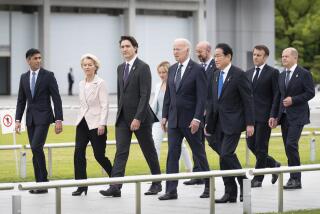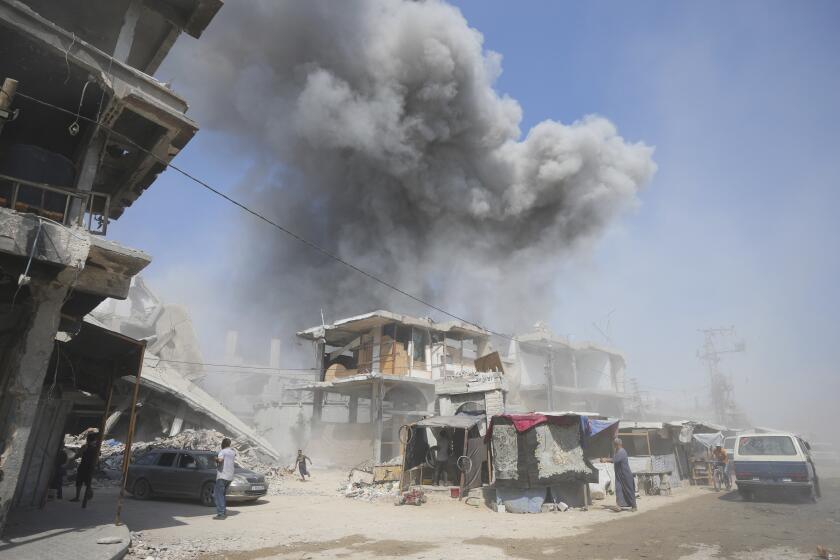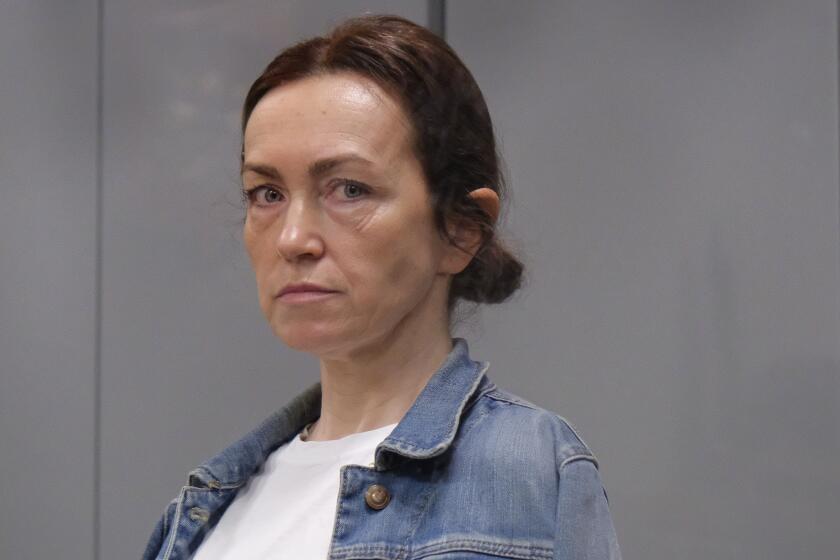Part of Social Fabric : Drug Lords Rule Over Rio’s Slums
To the wondering eyes of children in a slum called Jacarezinho, a helicopter suddenly appeared over the scruffy local plaza last Christmas Eve. In a twinkling, Santa Claus hopped down and began handing out thousands of gifts.
The kids of world-wise Jacarezinho do not really believe in Santa. Everyone knew the presents were from Paulo Roberto de Moura Lima, its most famous native son.
Lima was known in the Brazilian press as “Half-Kilo,” a wily drug trafficker and gang leader. But, in Jacarezinho, where he grew up poor and became wondrously rich and powerful, Half-Kilo was known as a winner among losers, a benefactor to the needy, a feared peacekeeper, a nice guy.
He was a prime example of the kind of men who have come to dominate many favelas, the teeming mazes of ramshackle dwellings that clutter the hillsides of picturesque Rio. The favelas began as clusters of squatters’ huts and, while still technically illegal, are recognized by officials as permanent fixtures.
Law enforcement officials acknowledge that drug chieftains often exercise a parallel power in the favelas, policing them against other criminals, providing food, funds and even medicine to the poorest residents--and demanding silent acquiescence to their illicit business.
It is a phenomenon that has spread from slum to slum in recent years, becoming part of the social landscape in Rio, a metropolis of more than 10 million people. An estimated 2 million people, often too poor to find housing anywhere else, live in more than 400 favelas here.
Rule From Behind Bars
Some of the favela drug lords eventually run afoul of the law and land in prison--and then continue to run their organizations from behind bars. Half-Kilo was one of those.
Last month, a small helicopter suddenly appeared over the courtyard of Frei Caneca prison, where Half-Kilo was being held. The chopper had been sent to whisk him away in what was planned as a spectacular escape.
But, as Half-Kilo was being pulled into the hovering craft, the plan went awry. Shots rang out, the helicopter was hit, Half-Kilo fell 30 feet to the ground, and the helicopter crashed.
Half-Kilo, 31, died later in a prison hospital. The shops of Jacarezinho closed in mourning. More than 2,000 people, most of them from the favela, attended the funeral.
“Hey, hey, hey, Half-Kilo is our king!” they shouted. “Hey, hey, hey, they killed our king!”
Police say that “Vando,” an associate of Half-Kilo, apparently has risen to take charge of the gang, which continues to reign in Jacarezinho.
Jorge Marques, chief of the narcotics division of Rio de Janeiro’s state civil police, said the Jacarezinho gang is the richest in Rio, retailing cocaine from five locations.
‘Smoky Doorways’
“All of that belonged to Half-Kilo,” Marques said in an interview.
The retail sales points in the favelas are called “smoky doorways.” Each has a manager, and the manager has salespeople called “airplanes”--they take off with merchandise and return with money.
The airplanes distribute cocaine in small paper packages. Usually their best customers are middle-class Brazilians who can better afford the drug than can slum residents. Some of the airplanes are as young as 13, and some make $50 on a good day--more than many workers earn in a month at legitimate jobs.
The well-armed drug trafficking gangs usually take over favelas by force, eliminating anyone who defies their authority, according to Marques.
“They control by intimidation,” he said. “Those who are not with them are killed or expelled from the hill.”
Youngsters Enlisted
Then the traffickers seek acceptance from their neighbors. “They are able to win over the residents with milk, bread, medicine,” Marques said. “At the same time that they are doing that, they enlist the youngsters to be airplanes.”
On a wall in Marques’ office hangs a large map, dotted with pins marking 62 favelas. Red strings stretch from the pins to labels bearing the names of drug traffickers with nicknames such as “King Kong,” “China,” “Hairy” and “Stepladder.”
The traffickers are able to operate because residents will not cooperate with the police against them, Marques said.
“There is the law of the favela,” he said. “No one saw, no one knows, no one will tell. It is a great barrier that the police encounter in any favela.”
The police are also handicapped by their scarce resources. The narcotics division has no funds for paying informants, Marques said. Even with eight new automobiles recently acquired, it has only 12 cars for its 140 detectives.
Popular Gangs
Residents of the favelas say there is no dispute: The local drug trafficking gangs are far more popular than the police.
“The residents wouldn’t want to trade the bandits for the police,” said Nilton Pereira, a resident of a favela called German’s Hill and vice president of the Federation of Favela Assns. of Rio de Janeiro, which represents citizens’ associations from 400 favelas.
“When the police come into the favela, they don’t come in to protect,” he said. “They come in to knock heads. They know that the doctor’s son doesn’t live there.”
The drug trafficking gangs, on the other hand, do not permit robberies and assaults inside the favela, Pereira said, because they mete out justice that is both swift and sure. “If someone starts robbing, the bandits kill him,” Pereira said.
Sergio Andrea, Rio’s municipal secretary of social development, acknowledged that the drug gangs are a power that the authorities have to deal with in the favelas.
“The traffickers are more respected than the police, unfortunately, and they provide more security than the police do,” Andrea said. “The police are poorly trained, insufficiently paid, and many times they are accomplices of the gang on the hill.”
Mutual Benefits
According to Andrea, more than half of Rio’s favelas are involved to some degree in a mutually beneficial relationship with drug trafficking gangs. He said the gangs have begun to take control over some residents’ associations, the main civic groups in most favelas.
“There are situations where that is beginning to happen,” he said, but he declined to give details. Police sources said the traffickers often donate funds to the associations, but association spokesmen said they knew of no such cases.
Some analysts trace the success of favela gangs back to state prisons in the late 1970s, when political prisoners were held in the same cell blocks with common criminals. Brazil then was governed by a military dictatorship.
The political prisoners, including captured urban guerrillas, taught the other convicts the value of organizational unity and good relations with local residents, according to the analysts.
“The common prisoners copied the techniques of the political prisoners,” said Aloisio Russo, a state civil police officer and one of Brazil’s leading police experts on drug trafficking.
The Red Phalanx
The convicts created crime syndicates that have grown stronger over the years and have found their most lucrative activity in the growing cocaine traffic. Jacarezinho’s Half-Kilo was a member of the biggest syndicate, known as the Red Phalanx.
The gangs have taken special care to cultivate the favelas for their purposes.
“They invest a part of what they make in the society,” Russo said. “They pay for medical treatment, they give parties, they contribute money to the residents’ associations, they buy equipment for the local soccer team. And they impose order in the community.
“They don’t do all that because they are good boys,” he said. “It is part of their business. On the other hand, it satisfies their egos to be adored by the community.”
The densely populated and hard-to-reach favelas are ideal redoubts for gangs. Strangers coming in are detected and announced by secret codes--words, whistles, even kites.
“The kids start to pull on their kites a different way when someone comes in,” urbanologist Jorge Francisconi said.
Low Public Investment
Francisconi is the president of the Fundacao Leao XIII, a state foundation dedicated to social work. He said public investment in favelas is so low that they are more ghettos than communities.
“Organized crime is providing services for these populations because public service is absent,” he said.
He said the gangs reached their current level of power and influence during the administration of former Gov. Leonel Brizola, a left-leaning populist who headed the state government from 1983 until last March.
Under Brizola, “the police were forbidden to go up the hills” into the favelas, Francisconi said. “The government thought that they were putting too much pressure on the population, hurting the population.”
The state uniformed police have earned a reputation for brutality and for corruption as well.
“It’s hard to tell where the police stops and the mafia starts,” Francisconi said.
Long, Difficult Process
Under the current administration of Gov. Wellington Moreira Franco, police are attempting to re-establish their presence in the favelas, but officials say it will be a long and difficult process.
The influence of the traffickers was made strikingly clear one day in August when hundreds of residents of Rocinha, Rio’s biggest favela, demonstrated violently on behalf of an imprisoned drug lord known only as Denis. Demanding Denis’ release or transfer, demonstrators stoned cars on a major thoroughfare.
For most of the day, traffic was stopped on the only direct artery between central Rio and the affluent beach neighborhood of Barra de Tijuca. Middle-class Rio residents were disturbed to see Denis’ supporters that evening on television news, rising up in anger a few hundred yards from fashionable condominiums and hotels.
TV viewers were shocked again in August when rival traffickers carried on a running gun battle in the Dona Marta favela. The gang war lasted nearly a week, ending when police swarmed through the favela and sent the rival gang leaders, Hairy and Zaca, into hiding.
‘One Big Family’
In Jacarezinho, Half-Kilo had no rival, and violence has been rare since he established his gang at the beginning of the 1980s.
“He made Jacarezinho into one big family, united against violence, against robberies and all that,” said one resident, a young man who works as an office messenger. “In Jacarezinho, people even sleep with their doors unlocked. I myself sleep with the door unlocked.”
Jacarezinho means “little alligator.” It sprawls over a broad hillside and along a river that carries raw sewage to Rio’s Guanabara Bay.
The poorest homes of Jacarezinho, rough wooden shacks, face the fetid river. Along the narrow, twisting lanes up the hill, the houses are jerry-built structures of cheap brick without enough mortar.
It is a community of 170,000 people, some better off than others. There are shops, bars and cafes along the main streets, and even a few cars.
The headquarters of the Jacarezinho Residents Assn. is a shabby and cramped two-story building in the heart of the favela.
Criticism of Government
Nilson de Brito, the association president, is a thin, graying man of 53 who sharply criticizes the government but carefully avoids saying anything against drug traffickers.
“Those people provide a service to the community while the public authority doesn’t,” he said. “The public authority does not meet the needs of the people.”
But he said the association receives no direct aid from the traffickers. “I don’t interfere in their business, and they don’t interfere in mine,” he said.
He said that how the traffickers deal with robbers and other criminals is not his business, but he denied that the traffickers execute offenders.
“They don’t kill, they expel,” he said.
A local shopkeeper, however, said repeat offenders are killed by the gang.
“It grabs the guy, ties his wrists, puts him in a bag and throws him in the river,” said the shopkeeper. “It kills. It exterminates.”
As a result, merchants in the favela feel secure.
‘Open All Night’
“For the past seven years, I can leave this store open all night, and nothing happens,” he said.
The shopkeeper remembered Half-Kilo less as a ruthless enforcer than as a popular patron.
At the same plaza where he dispatched Santa Claus by helicopter, Half-Kilo paid for daily distribution of hot soup to hungry slum dwellers. He gave money for medical prescriptions and building materials. He sponsored lavish street parties with “the best samba singers,” the shopkeeper said.
Dozens of youths worked for Half-Kilo in his drug business, the shopkeeper said. “He had many airplanes. He treated them with respect.”
Even Father Nelson Carlos Del Monaco, who built the Roman Catholic church at the top of the hill in Jacarezinho, has good things to say about Half-Kilo, depicting him as a nice boy who took a wrong turn.
“Pardon me for speaking well of him, but that is the reality,” Del Monaco said.
More to Read
Sign up for Essential California
The most important California stories and recommendations in your inbox every morning.
You may occasionally receive promotional content from the Los Angeles Times.






